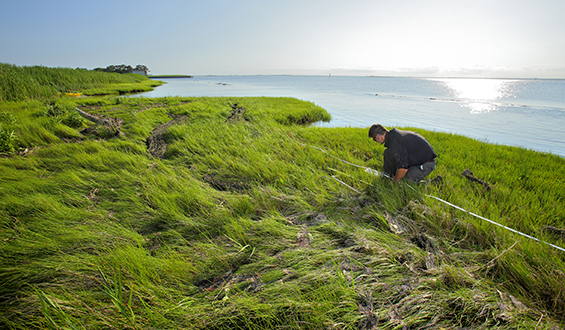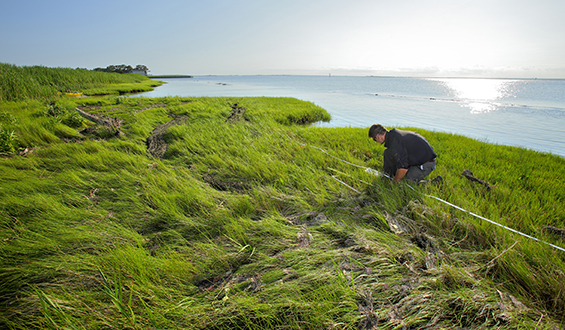 Misericordia University biology major Hunter D. Pates of Columbus, N.J., inspects the transect he established on Mordecai Island to study fiddler crab burrows and crustacean population.
Misericordia University biology major Hunter D. Pates of Columbus, N.J., inspects the transect he established on Mordecai Island to study fiddler crab burrows and crustacean population.
Hunter D. Pates knows how to tackle.
He ably brings down running backs from his linebacker position on the football field, and addresses myriad issues that are important to the student body on campus as vice president of the Student Government Association at Misericordia University.
The Columbus, N.J., native, though, is most proud of his ability to undertake important academic and environmental issues as an undergraduate research scientist and burgeoning coastal ecologist. Pates was one of 28 undergraduate students and 14 faculty members who participated in the 2015 Misericordia University Summer Research Fellowship Program from May 26 to July 31.
“The big thing is over my first three years at Misericordia I really established a strong base on the overall scientific process,’’ Pates says about his undergraduate education. “With that kind of training, it allowed me to go out and put all of those skills to work. It helped make the process feel much easier and go much smoother. What I liked about the fellowship program is I pretty much had the freedom to develop my own research project.
“I felt like I had the freedom to reach out to other scientists in the field and establish that line of communication while getting their feedback and help. That’s something I wouldn’t have had if I went to a larger research fellowship program or larger school,’’ he adds.
The University-sponsored opportunity took him from the on-campus laboratories in Hafey-McCormick Science Hall, where his interdisciplinary research with fiddler crabs began with Barbara McCraith, Ph.D., associate professor of biology, to the endangered coastal salt marshes, salt marsh islands and shorelines of Ocean and Cumberland counties in New Jersey. His summer work also enabled him to appreciate the roles biologists and engineers play in fully understanding the coastal system, including the geology, chemistry and biology of this fragile environment, and how best to protect it.
“The work he did was outstanding,’’ says Dr. McCraith. “He really gets science. I saw it happen his sophomore year. He was turned on by science. He got bit by the research bug.’’
The goal of Pates’ investigation was twofold, as he sought to compare the effectiveness of two different shoreline erosion prevention-restoration projects on Mordecai and Money Islands, and the impact erosion has on the fiddler crab population.
The shore is somewhat of a second home for Pates, as he grew up an hour’s drive from the beach on Joint Base McGuire-Dix-Lakehurst, a military facility about 18 miles outside of Trenton, N.J., with his parents, MSgt. Timothy and Judith Pates. His exploration of beaches in Sea Girt, N.J., during his childhood, and now Beach Haven, Long Beach Island, N.J., shaped a lot of his beliefs on conservation efforts in his home state and elsewhere.
“Just growing up and going down to the shore has helped me to appreciate all that nature has to offer to us,’’ he says, reflecting on his formative years around the ocean that included building elaborate sand castles and seemingly nonstop boogie boarding. “And now being able to advocate for environmental causes helps to ensure people will always be able to utilize nature and all it has to offer.’’
AN ESTUARY LIFE
A soft-spoken senior, Pates plans on attending graduate school for coastal ecologyso he can continue conducting research that has a positive impact on the environment – even one day working for the U.S. Environmental Protection Agency. The undergraduate scientist in him reveals his practice of meticulous preparation, as he reviews notes, pictures and his already completed research poster while reviewing the collaborative work.
His research topic, “A Living Shoreline Approach to Erosion Prevention and its Effect on Fiddler Crab Burrow Densities on Mordecai Island, Barnegat Bay and Money Island,” required periodic kayak trips by himself since the locations were inaccessible by other means. On Mordecai Island, he established experimental and control sites to quantify the abundance and quality of fiddler crab burrows. He did the same at Money Island, which is technically considered a cape. In each quadrat, Pates counted the burrows and measured their diameters every two weeks at each site in an effort to determine how healthy the environment was for the crabs and other native species of plants, birds and fish.
“Salt marshes, in general, are important as they serve as a filtering system for pollutants,’’ says Pates, a Northern Burlington County Regional High School graduate and biology major at Misericordia University. “If they are healthy, it will take away wave energy from hurricanes and storms. They also act as a nursery for juvenile fish, fiddler crabs and other organisms.’’
His research was enhanced by ReClam the Bay, a regional educational and environmental nonprofit in Toms River, N.J., that reintroduces clams and oysters to the Barnegat Bay estuary to improve water quality; Barnegat Bay Partnership, a national estuary program in Seaside Park, N.J., that works to protect and enhance the Barnegat Bay ecosystem, and the Wilmington, Del.-based Partnership for the Delaware Estuary, one of 28 National Estuary Programs that work to improve the health of estuaries. Representatives of the organizations granted him access to Mordecai Island in the Barnegat Bay complex, and Money Island in Downe Township, that were critical to his research, and also offered him feedback.
Mordecai and Money islands are very similar in size, composition and importance in this complex ecosystem. Mordecai is an uninhabited 45-acre coastal marsh island that is a haven to migrating and indigenous birds and fish. Since the 1930s, about 26 acres of the island’s western shore have been lost to storm and manmade erosion, according to New Jersey Audubon. Money is bordered by the Delaware Bay and Gandy’s Beach Preserve.Their importance to this fragile ecosystem, though, also cannot be underestimated as it is a refuge for endangered bird species, like the Black Skimmer, American Oystercatchers and Yellow-crowned Night-Herons, according to the New Jersey Audubon.
This is where their similarities end, though, as different methods are being employed on these coastal shorelines to protect them from erosion, and to rebuild their shorelines and natural habitats.
EROSION PREVENTION
Along the Money Island coast, scientists constructed living shorelines in the spring of 2014. Living shorelines is a relatively new concept along the Northeast Coast, but it has been used off the coasts of the Carolinas, Georgia, Florida and Louisiana to manage vanishing shorelines due to natural erosion and destructive hurricanes. Natural shorelines utilize organic materials to protect the shore from the energy of waves and to rebuild and, in turn, repopulate the shores with native species. A healthy and stable shoreline, for example, will have an ample supply of ribbed muscles in the sand, while also stimulating the proliferation of tall grasses that attract nesting birds, like the Piping Plover.
By utilizing coconut or coir fiber logs situated between wooden posts, and positioning oyster bags – mesh bags filled with oyster shells – in front of the fiber logs at Money Island, erosion slowed and fresh sediment was retained that enabled fresh vegetation growth and a healthy environment for native species.
Erosion has devoured most of Mordecai Island’s lower marsh through the years. Conservation efforts here are being enhanced by manmade geotubes – long, high-strength woven geotextile tubes filled with sand – that are placed offshore to absorb wave energy. The first phase of the project was completed in 2009. It has yet to be determined when the project will be completed.
A HEALTHY ENVIRONMENT
Fiddler crabs are a good tool to measure a healthy shore environment. An abundance of the small crustaceans, for example, indicates a healthy salt marsh, while plentiful, but smaller burrow sizes indicate an increased recruitment of the crabs into the environment. An abundant fiddler crab population also aerates the soil, which encourages native grasses, like cord grass Spartina alterniflora, to take root. Conversely, fewer burrows exist on shorelines with active erosion.
Pates’ research data show the living shoreline is more effective in “enhancing fiddler crab recruitment and in reestablishing marsh habitat’’ compared to the geotubes. Money Island’s density for burrows was 118 per meter square, while Mordecai’s was only 23 per meter square. Therefore, his research suggest that the use of organic material is more effective than geotubes in “enhancing fiddler crab recruitment and in reestablishing marsh habitat.”
“His research is important for a couple of reasons,’’ Dr. McCraith adds, while reviewing a copy of his poster presentation. “It’s important for Hunter himself, as he made connections and started networking with people in research in New Jersey and Delaware. From that, he has really started to develop an understanding of the interconnectedness of everything in the marine system there – not just the science, but the economy and the social impacts as we start losing the shoreline.
“As the students in our internship program develop a better understanding of their research and the impact of shoreline erosion, they are hopefully going to be leaders in their communities, and they can educate people and influence policy based on that level of understanding. The education we are giving our students is going to carry on through their whole life.’’
Misericordia Student Research Fellow Tackles Shoreline Issues
0
Share.




